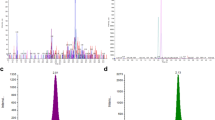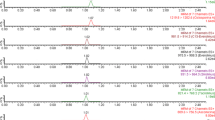Abstract
Tacrolimus (TAC) is an immunosuppressant widely used in organ transplantation, but its extremely low aqueous solubility causes poor intestinal absorption. There have been efforts to develop an alternative TAC formulation with an improved dissolution rate and oral bioavailability (BA), and the development of a rapid and sensitive analytical method for its in vivo pharmacokinetic study is an essential prerequisite. Thus, here, we develop a novel method to determine TAC in rat whole blood based on liquid chromatography and tandem mass spectrometry, and liquid–liquid extraction (LLE) with mild temperature ultrasonication. For rapid and efficient separation of TAC from other hydrophobic compounds, a C8 column was chosen with isocratic mobile phase elution. With the help of the high specificity and the high sensitivity of multiple reaction monitoring in positive ion mode, the present method showed good performance including specificity, linearity (r2 ≥ 0.996 within 1–200 ng/mL), sensitivity (the lower limit of quantitation at 1 ng/mL), intra- and inter-day accuracy (88.7–104.5 %) and precision (≤10.3 %), and recovery (94.7–102.6 %). Also, the stability of TAC and ascomycin, the internal standard, in rat whole blood was confirmed before and after the sample preparation. The validated method was satisfactorily applied to a pharmacokinetic study to determine TAC in rat whole blood following oral administration of the marketed product (Prograf®, Astellas Pharma). In the present study, LLE with mild temperature ultrasonication was successfully expanded to the determination of a drug from whole blood or plasma for the first time. Therefore, the present method can contribute to the rapid in vivo evaluation of novel TAC formulations, and will be able to contribute to the development of TAC formulations with a higher dissolution rate and a higher BA.




Similar content being viewed by others
References
Amstrong VW, Oellerich M (2001) New developments in the immunosuppressive drug monitoring of cyclosporine, tacrolimus, and azathioprine. Clin Biochem 34:9–16
Araki N, Horiuchi S, Rahim ATMA, Takata K, Morino Y (1990) Microquantification of cholesterol and cholesteryl esters in rat peritoneal macrophages by reverse-phase high-performance liquid chromatography. Anal Biochem 185:339–345
Bowers LD (1998) Analytical goals in therapeutic drug monitoring. Clin Chem 44:375–380
Burdick D, Soreghan B, Kwon M, Kosmoski J, Knauer M, Henschen A, Yates J, Cotman C, Glabe C (1992) Assembly and aggregation properties of synthetic Alzheimer’s A4/β amyloid peptide analogs. J Biol Chem 267:546–554
Cassol S, Weniger BG, Babu PG, Salminen MO, Zheng X, Htoon MT, Delaney A, O’Shaughnessy M, Ou CY (1996) Detection of HIV type 1 env subtypes A, B, C, and E in Asia using dried blood spots: a new surveillance tool for molecular epidemiology. AIDS Res Hum Retrovir 12:1435–1441
Choi YS, Wood TD (2008) Silanization of inner surfaces of nanoelectrospray ionization emitters for reduced analyte adsorption. Rapid Commun Mass Spectrosc 22:1265–1274
Choi YS, Hou S, Choe LH, Lee KH (2013) Targeted human cerebrospinal fluid proteomics for the validation of multiple Alzheimer’s disease biomarker candidates. J Chromatogr B 930:129–135
Christians U, Braun F, Schmidt M, Kosian N, Schiebel HM, Ernst L, Winkler M, Kruse C, Linck A, Sewing KF (1992) Specific and sensitive measurement of FK506 and its metabolites in blood and urine of liver-graft recipients. Clin Chem 38:2025–2032
Christians U, Jacobsen W, Benet LZ, Lampen A (2002) Mechanisms of clinically relevant drug interactions associated with tacrolimus. Clin Pharmacokinet 41:813–851
Christine E, Susan E (2004) Clinical pharmacokinetics and pharmacodynamics of tacrolimus in solid organ transplantation. Clin Pharmacokinet 43:623–653
Cole RB, Harrata AK (1992) Charge-state distribution and electric-discharge suppression in negative-ion electrospray mass spectrometry using chlorinated solvents. Rapid Commun Mass Spectrosc 6:536–539
Craig DQM (2002) The mechanisms of drug release from solid dispersions in water-soluble polymers. Int Pharm 231:131–144
de Mattos AM, Olyaei AJ, Bennett WM (2000) Nephrotoxicity of immunosuppressive drugs: long-term consequences and challenges for the future. Am J Kidney Dis 35:333–346
Food and Drug Administration of the United States (2013) Guidance for industry-bioanalytical method validation. U.S. Department of Health and Human Services, Center for Drug Evaluation and Research (CDER)
Gummert JF, Ikonen T, Morris RE (1999) Newer immunosuppressive drugs: a review. J Am Soc Nephrol 10:1366–1380
Kino T, Hatanaka H, Miyata S, Inamura N, Nishiyama M, Yajima T, Goto T, Okuhara M, Kohsaka M, Aoki H, Ochiai T (1987) FK-506, a novel immunosuppressant isolated from a Streptomyces. II. Immunosuppressive effect of FK-506 in vitro. J Antibiot 40:1256–1265
Klein I, Abrahams A, van Ede T, Hene RJ, Koomans HA, Ligtenberg G (2002) Different effects of tacrolimus and cyclosporine on renal hemodynamics and blood pressure in healthy subjects. Transplantation 73:732–736
Koop DR, Bleyle LA, Munar M, Cherala G, Al-Uzri A (2013) Analysis of tacrolimus and creatinine from a single dried blood spot using liquid chromatography tandem mass spectrometry. J Chromatogr B 926:54–61
Koster RA, Alffenaar JWC, Greijdanus B, Uges DRA (2013) Fast LC–MS/MS analysis of tacrolimus, sirolimus, everolimus and cyclosporin A in dried blood spots and the influence of the hematocrit and immunosuppressant concentration on recovery. Talanta 115:47–54
Li JL, Wang XD, Wang CX, Fu Q, Liu LS, Huang M, Zhou SF (2008) Rapid and simultaneous determination of tacrolimus (FK506) and diltiazem in human whole blood by liquid chromatography-tandem mass spectrometry: Application to a clinical drug-drug interaction study. J Chromatogr B 867:111–118
Li Q, Cao D, Huang Y, Xu H, Yu C, Li Z (2013) Development and validation of a sensitive LC–MS/MS method for determination of tacrolimus on dried blood spots. Biomed Chromatogr 27:327–334
McDade TW, Williams S, Snodgrass JJ (2007) What a drop can do: dried blood spots as a minimally invasive method for integrating biomarkers into population-based research. Demography 44:899–925
Mei JV, Alexander JR, Adam BW, Hannon WH (2001) Use of filter paper for the collection and analysis of human whole blood specimens. J Nutr 131:1631S–1636S
Oe T, Ackermann B, Inoue K, Berna MJ, Garner CO, Gelfanova V, Dean RA, Siemers ER, Holtzman DM, Farlow MR, Blair IA (2006) Quantitative analysis of amyloid β peptides in cerebrospinal fluid of Alzheimer’s disease patients by immunoaffinity purification and stable isotope dilution liquid chromatography/negative electrospray ionization tandem mass spectrometry. Rapid Commun Mass Spectrosc 20:3723–3735
O’Grady JG, Burroughs A, Hardy P, Elbourne D, Truesdale A (2002) Tacrolimus versus microemulsified ciclosporin in liver transplantation: the TMC randomized controlled trial. Lancet 360:1119–1125
Park YJ, Ryu DS, Li DX, Quan QZ, Oh DH, Kim JO, Seo YG, Lee YI, Yong CS, Woo JS, Choi HG (2009) Physicochemical characterization of tacrolimus-loaded solid dispersion with sodium carboxylmethyl cellulose and sodium lauryl sulfate. Arch Pharm Res 32:893–898
Patel P, Patel H, Panchal S, Mehta T (2012) Formulation strategies for drug delivery of tacrolimus: an overview. Int J Pharm 2:169–175
Qin XL, Bi HC, Wang CX, Li JL, Wang XD, Liu LS, Chen X, Huang M (2009) Study of the effect of Wuzhi tablet (Schisandra sphenanthera extract) on tacrolimus tissue distribution in rat by liquid chromatography tandem mass spectrometry method. Biomed Chromatogr 24:399–405
Suthanthiran M, Morris RE, Strom TB (1996) Immunosuppressants: cellular and molecular mechanisms of action. Am J Kidney Dis 28:159–172
Tada H, Yanagiwara S, Ito K, Suzuki T (1999) Role of diltiazem on tacrolimus pharmacokinetics in tacrolimus-induced nephrotoxic rats. J Pharmacol Toxicol Methods 84:241–246
Tamura S, Ohike A, Ibuki R, Amidon GL, Yamashita S (2002) Tacrolimus is a class II low-solubility high-permeability drug: the effect of P-glycoprotein efflux on regional permeability of tacrolimus in rats. J Pharm Sci 91:719–729
Tanaka H, Kuroda A, Marusawa H, Hashimoto M, Hatanaka H, Kino T, Goto T, Okuhara M (1987) Physicochemical properties of FK-506, a novel immunosuppressant isolated from Streptomyces tsukubaensis. Transpl Proc 19:11–16
Tsang VWH, Lei NY, Lam MHW (2009) Determination of Irgarol-1051 and its related s-triazine species in coastal sediments and mussel tissues by HPLC–ESI-MS/MS. Mar Pollut Bull 58:1462–1471
Undre NA (2003) Pharmacokinetics of tacrolimus-based combination therapies. Nephrol Dial Transpl 18:i12–i15
Undre NA, Stevenson P, Schafer A (1999a) Pharmacokinetics of tacrolimus: clinically relevant aspects. Transpl Proc 31:S21–S24
Undre NA, von Hooff J, Christiaans M, Vanrenterghem Y, Donck J, Heeman U, Kohnle M, Zanker B, Land W, Morales JM, Andres A, Schafer A, Stevenson P (1999b) Low systemic exposure to tacrolimus correlates with acute rejection. Transpl Proc 31:296–298
Venkataramanan R, Swaminathan A, Prasad T, Jain A, Zuckerman S, Warty V, McMichael J, Lever J, Burckart G, Starzl T (2005) Clinical pharmacokinetics of tacrolimus. Clin Pharmacokinet 29:404–430
von Ahsen N, Chan A (2012) Therapeutic monitoring of immunotherapies in autoimmune diseases. Curr Pharm Des 18:4550–4555
Wilhelm L, Nitschke M, Meier M, Vonthein R, Kramer J (2013) Determination of calcineurin inhibitors in dried blood spots from kidney transplant recipients. Am J Anal Chem 4:27–35
Acknowledgments
The present research was conducted by the research fund of Dankook University in 2013 (YSC).
Conflict of interest
None.
Author information
Authors and Affiliations
Corresponding author
Rights and permissions
About this article
Cite this article
Park, J.S., Cho, H.R., Kang, M.J. et al. A rapid and sensitive method to determine tacrolimus in rat whole blood using liquid–liquid extraction with mild temperature ultrasonication and LC–MS/MS. Arch. Pharm. Res. 39, 73–82 (2016). https://doi.org/10.1007/s12272-015-0681-9
Received:
Accepted:
Published:
Issue Date:
DOI: https://doi.org/10.1007/s12272-015-0681-9




